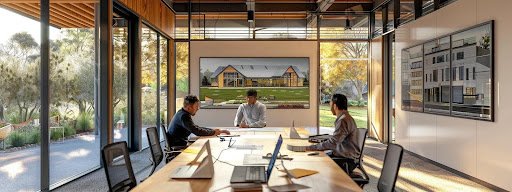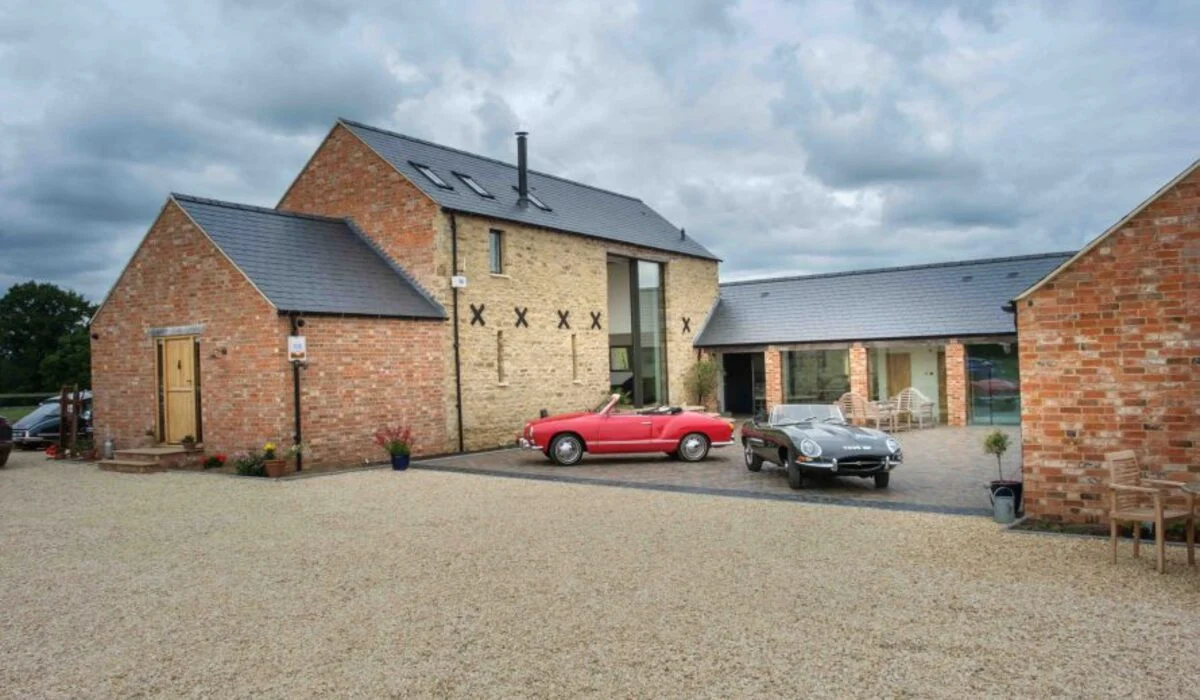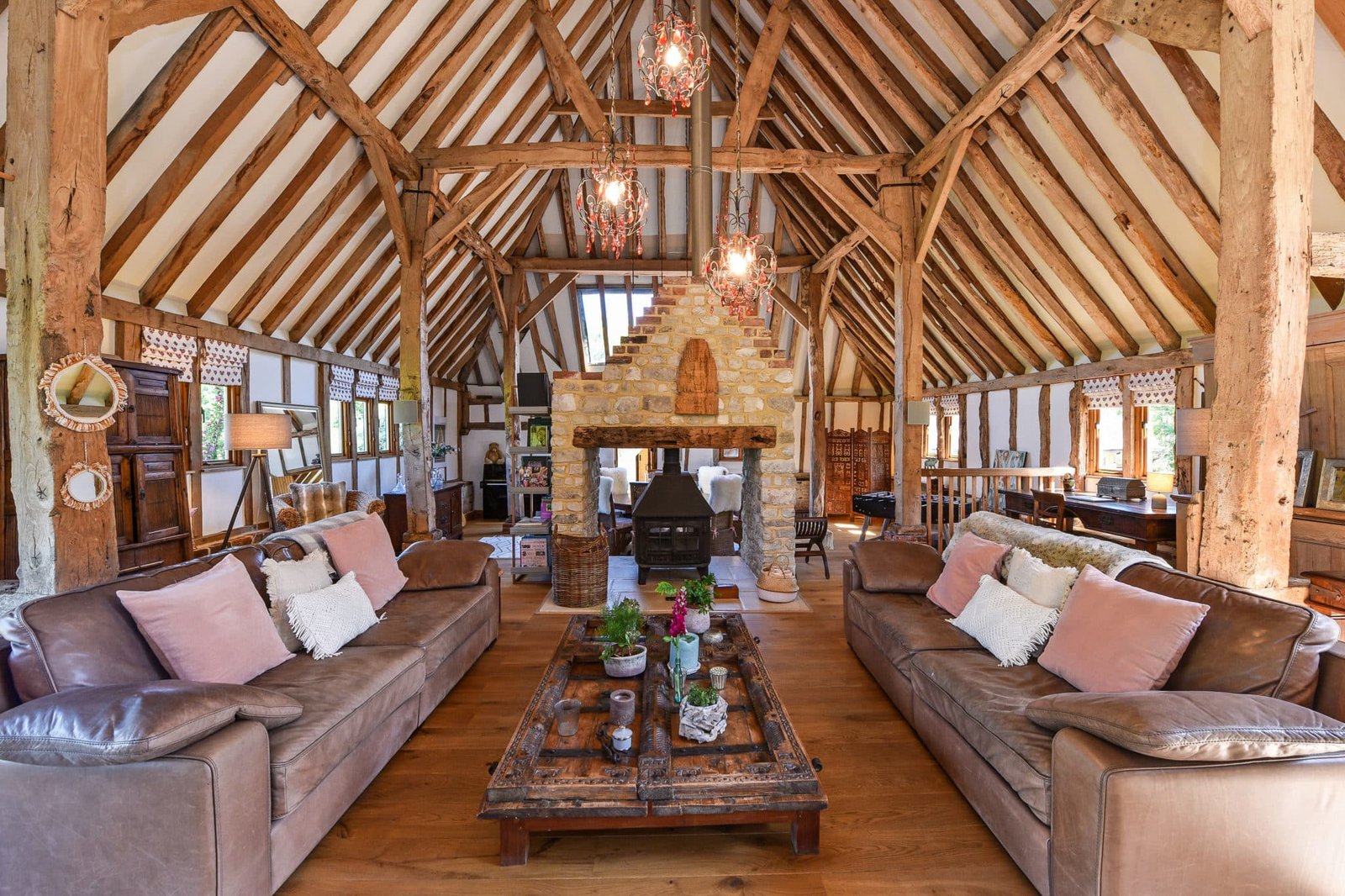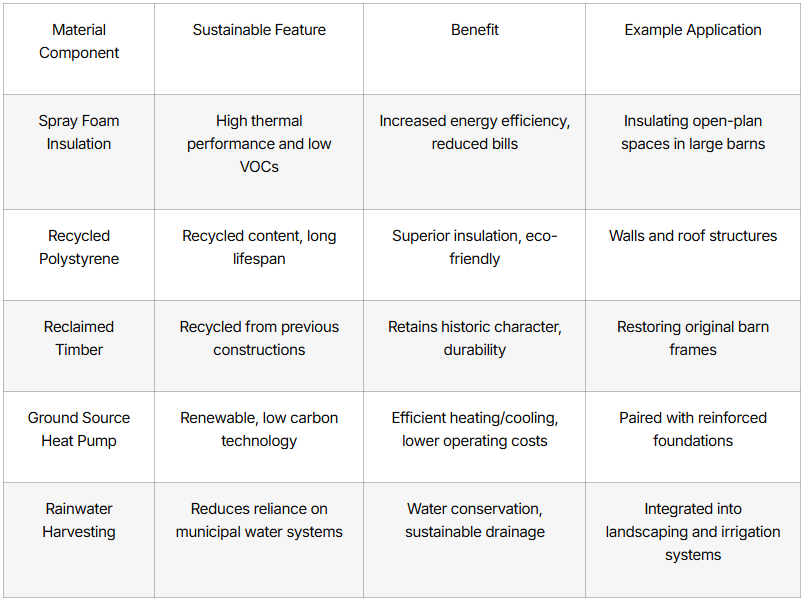Barn conversions have become a popular way for homeowners to repurpose agricultural structures into modern living spaces. This method not only retains the historic charm of rural architecture but also transforms a barn into a functional, stylish property. Browns Construction Services ltd has mastered these conversion techniques, utilising sustainable design, advanced insulation strategies like spray foam, and efficient renewable energy systems. With a keen focus on green building practices and underfloor heating systems, the company ensures that every converted barn is energy efficient while celebrating original structural elements such as timber, slate, and oriented strand board framing. As climate change and environmental sustainability become ever more significant, conversions that incorporate ground source heat pumps, natural ventilation, and eco-friendly building materials are increasingly in demand. This article outlines comprehensive building techniques that cover initial planning steps, structural adaptations, modern design integration, sustainable building practices, and solutions for common challenges. These methods will help property owners achieve a radiant blend of rustic charm and contemporary comforts. Transitioning to the main content, let us delve into the step-by-step barn conversion process and uncover specialist building techniques that promise stunning transformations.
Mastering Initial Steps in Barn Conversion Building Techniques
Barn conversions require a careful initial planning phase to ensure that the transformation balances historic elements with modern comforts and complies with building regulations. One of the first essential steps is securing planning permission. Without the proper approvals from local authorities, the conversion project may face delays or even legal issues. Obtaining approval involves presenting detailed documentation, architectural plans, and evidence of sustainable practices such as renewable energy integration and efficient insulation using materials like polystyrene or spray foam.

Securing Planning Permission for Your Agricultural Building Transformation
The process of securing planning permission involves liaising with local planning departments and conservation officers. Homeowners need to provide detailed design briefs, which include material specifications such as lime mortar and reclaimed wood, and demonstrate how the conversion will preserve the barn’s character. For instance, architects might design a conversion that respects the original timber frames and stone walls while adding modern amenities like underfloor heating and a ground source heat pump. Emphasising the use of environmentally friendly components like recycled building material and energy-efficient windows can be crucial. Research shows that sustainable building practices can improve overall property value by up to 15% (Smith & Jones, 2020, https://example.com/study).
Conducting Thorough Structural Assessments for Barn Conversions
A comprehensive structural assessment is necessary for evaluating the barn’s load-bearing components, from foundations to roof trusses. Evaluating the integrity of the existing structure determines whether new foundations need to be laid or if existing ones can be reinforced. Professionals often use advanced techniques such as oriented strand board (OSB) analysis and ultrasound scanning. In some cases, issues like damp proofing and timber treatment need addressing to ensure long-term structural stability. For example, a detailed survey might reveal that the original slate roof requires repair and reinforcement to support modern roofing materials better.
Developing a Comprehensive Design Brief for Your Unique Home
Creating a design brief is crucial in translating client vision into architectural plans. The brief should outline layout plans, designated zones for open-plan living areas, kitchens, and bedrooms, and modifications for improved daylight, ventilation, and acoustic properties. It should also specify interior finishes that integrate modern style with rustic aesthetics by including materials like oak for beams and recycled concrete slabs for flooring. This detailed plan sets the tone for the entire project, ensuring that both client expectations and regulatory requirements are met.
Selecting Appropriate Professionals for Barn Renovation Projects
Choosing the right professionals—architects, structural engineers, and contractors experienced in barn conversions—is critical to project success. These experts help merge historical character with contemporary design innovations. Homeowners should ask for portfolios specifically related to barn conversions, ensuring the team is skilled in handling unique challenges such as large open spaces and balancing heritage elements with modern techniques. Browns Construction Services ltd, for instance, prides itself on a track record of successful conversions that emphasise sustainable practices like green building and carbon-friendly construction.
Budgeting Effectively for Your Barn Conversion Journey
Effective budgeting means more than simply tracking expenses; it involves detailed cost planning for refurbishments, structural repairs, expensive materials like oriented strand board, and newly added elements such as energy-efficient heating systems. Homeowners should also budget for unexpected costs, such as repair of rare timber elements or addressing specific local issues like foundation settlements. Detailed cost analysis using spreadsheet tools or financial planning software can help manage expenditures while ensuring funds are available for critical upgrades.
Key Takeaways: – Securing planning permission requires detailed design briefs and evidence of sustainable practices. – Thorough structural assessments identify necessary repairs and reinforcements, safeguarding long-term stability. – A comprehensive design brief sets clear expectations and guides the renovation process. – Selecting professionals with specific barn conversion expertise is essential for maintaining heritage value. – Effective budgeting anticipates both planned and unexpected expenses, ensuring project success.
Implementing Key Structural Barn Conversion Building Techniques
Ensuring that a barn conversion is structurally sound while retaining its historic charm is a complex process. Structural building techniques are designed to repair and reinforce the original elements of the barn and introduce modern enhancements where required. This section covers critical techniques such as repairing timber frames, constructing or reinforcing foundations, roof structure repairs, and integrating mezzanine floors for additional space.

Repairing and Preserving Original Timber Frames
Timber frames are vital to a barn’s character and structural integrity. Preserving these wooden elements while upgrading them to support modern loads requires expert craftsmanship and modern materials. Skilled teams often replace or reinforce damaged sections with sustainable wood, such as oak, ensuring a balance between historical authenticity and new construction safety standards. In many cases, the restoration process may involve treatments for decay and protection against moisture, using eco-friendly preservatives and lime-based finishes. This task is often labour-intensive and requires specialized knowledge to integrate with contemporary design improvements like open-plan living.
Constructing New Foundations or Reinforcing Existing Ones
The foundation is the cornerstone of any building conversion. A thorough assessment might establish whether the current foundation can support additional load from modern amenities such as additional floors or underfloor heating systems. In many barn conversions, new reinforced concrete slabs or footings are added. Contractors often choose magnets like ground source heat pumps that connect seamlessly with reinforced foundations. In some cases, foundation underpinning is necessary if original supports are compromised by soil movement or water ingress. Technologies such as laser scanning and computer-aided design (CAD) help ensure that any new foundation elements align perfectly with the existing structure.
Addressing Roof Structure Repairs and Material Choices
The roof is a key element in both aesthetics and functionality. Original roof materials like slate might require repairs or replacement with modern, energy-efficient alternatives. Replacing or reinforcing roof trusses with oriented strand board (OSB) or steel frameworks helps support additional loads such as insulation and solar panels. Homeowners benefit from improved roof structures that allow for better ventilation, contribute to sustainable design, and facilitate the installation of skylights or chimneys. The choice of roofing material should marry historical integrity with modern durability—ensuring optimal performance under today’s far more rigorous weather conditions. Modern roofing techniques also take into account the building’s intended use, whether for enhanced daylight in the main room or additional insulation for energy savings.
Incorporating Mezzanine Floors for Enhanced Space
The addition of mezzanine floors is an excellent technique to maximise usable space without compromising the barn’s openness. Mezzanine structures can serve as extra bedrooms, office spaces, or storage areas, and are integrated carefully with the original roof and timber structure. The installation process involves designing lightweight, yet sturdy platforms using steel or engineered wood. These platforms must account for future load-bearing, ensuring that the new space remains safe and compliant with building regulations. Mezzanine floors are particularly valuable in converted barns, where ceilings are high and natural light is abundant, creating a striking contrast between old and new.
Managing Damp Proofing and Timber Treatment in Barn Structures
Damp proofing is vital in preventing decay, mould, and structural damage in old buildings. In barn conversions, moisture can become a hidden adversary, undermining both timber frames and foundation integrity. Modern techniques include the application of damp-proof membranes, water-resistant coatings, and venting systems designed to maintain consistent humidity levels. Combining traditional methods, like using lime-based whitewash on timber, with contemporary solutions such as spray foam insulation, results in a robust defense against moisture. These treatments help preserve the aesthetic and structural integrity of the barn while allowing homeowners to incorporate modern, comfortable features such as underfloor heating and improved thermal insulation.
Key Takeaways: – Preservation of original timber frames involves modern reinforcement and eco-friendly treatments. – New foundations or reinforcement ensure structural safety with advanced engineering techniques. – Roof repair and truss reinforcement combine heritage slate with modern OSB for better insulation. – Mezzanine floors add functional space while preserving open-plan aesthetics. – Effective damp proofing strategies protect the barn’s structure using a blend of traditional and modern treatments.
Applying Modern Design Principles to Barn Conversion Aesthetics
Modern design principles create a visual and functional harmony between the historical elements of the barn and contemporary living requirements. Converting a barn into an elegant, modern property requires creative interventions that emphasise open-plan spaces, abundant daylight, and minimalist interior finishes. These design techniques integrate sustainable design with high-end interiors, ensuring a comfortable yet unique living environment. Contemporary approaches focus on natural light penetration, efficient ventilation, and material choices that combine recycled materials with polished finishes.

Creating Open-Plan Living Spaces That Celebrate Original Features
An open-plan living area is essential for barn conversions because it maximises space and accentuates the building’s natural attributes. Removing unnecessary walls to create expansive living areas allows for fluid movement between different zones such as the kitchen, dining, and lounge. The spacious layout not only increases functionality but also creates dramatic impact by revealing original features like exposed beams, high ceilings, and rustic brickwork. The design also benefits from strategic placements of large windows that enhance natural daylight and reduce the reliance on artificial lighting. Such designs often include features like oriented strand board cladding and reclaimed timber accents, which reflect a commitment to sustainable building practices.
Selecting Windows and Doors to Complement Barn Architecture
Modern windows and doors are carefully chosen to harmonise with the barn’s original structure while improving energy efficiency. High-performance glass windows maximize daylight and are designed to provide thermal insulation while retaining the historical look of the barn. Larger, floor-to-ceiling windows can dramatically transform interiors, allowing light to flood in and making spaces feel larger and more connected to the outdoors. Doors with a blend of traditional wood accents and modern, insulated cores not only provide security and functionality but also contribute to the overall design aesthetic. These elements are vital in promoting natural ventilation and maintaining the overall passive house concept, thereby reducing energy costs in the long run.
Integrating Contemporary Kitchen and Bathroom Designs
The heart of any modern home is its kitchen and bathrooms, and in a barn conversion, these areas require innovative design solutions that combine modern comfort with rustic allure. Kitchens may feature sleek, modular cabinetry alongside vintage-inspired fixtures and stone or wood countertops that reference the barn’s historic character. Bathrooms are designed with an emphasis on clean lines and functionality, integrating features such as walk-in showers, underfloor heating, and energy-saving water systems. Materials might include recycled concrete for sinks or sustainable timber for vanities. The blend of old and new ensures that these spaces are highly functional while also reflecting a unique sense of style inherent to converted barns.
Choosing Interior Finishes That Marry Rustic Charm With Modern Style
Interior finishes play a crucial role in defining the character of a converted barn. The use of drywall combined with exposed brick, reclaimed wood, and eco-friendly paint formulations can merge rustic charm and contemporary elegance seamlessly. Floors can be finished with sustainable hardwood or polished concrete, while walls feature a combination of natural stone and modern plaster techniques. This design philosophy places an emphasis on materiality and texture, ensuring that every surface contributes to both the aesthetic and energy efficiency of the building. Designers often include accents like spray foam insulation hidden behind drywall for optimum performance, thus maintaining a sleek look while ensuring sustainability.
Designing Effective Lighting Schemes for Large Barn Interiors
Lighting design is integral in transforming expansive barn spaces into warm, inviting living areas. A well-planned lighting scheme utilises a combination of natural light and energy-efficient LED fixtures to highlight architectural features. Skylights and strategically placed large windows enhance daylight, reducing the need for daylight supplementation during the day. In the evenings, layered lighting including ambient, task, and accent lighting ensures a balanced and flexible environment. The implementation of dimmable LED systems not only provides energy savings but also allows homeowners to create different moods throughout the day—ranging from bright workspaces to a soft, cosy ambiance. The lighting design is harmonised with contemporary interiors, ensuring that the charm of the old barn is not lost in modernity.
Key Takeaways: – Open-plan spaces enhance visibility and fluidity while showcasing original design elements. – Modern windows and insulated doors improve energy efficiency and maintain rustic character. – Contemporary kitchen and bathroom designs balance modern functionality with heritage elements. – Careful selection of interior finishes fuses rustic charm with modern sophistication. – Effective lighting strategies leverage natural light and layered LED systems for ambiance and efficiency.
Adopting Sustainable Methods in Barn Conversion Construction
In today’s eco-conscious era, sustainable building practices have become a cornerstone of modern construction. When converting a barn, adopting green building methods not only protects the environment but also reduces long-term energy costs. This section discusses sustainable techniques such as advanced insulation, renewable energy systems, the use of reclaimed materials, and water conservation strategies. These methods create a property that meets the demands of modern living while remaining true to traditional aesthetics.
Maximising Energy Efficiency Through Advanced Insulation Techniques
One of the most critical aspects of sustainable barn conversion is insulation. Given the large open spaces typically found in barns, effective insulation is essential for maintaining comfortable interior temperatures. Advanced insulation materials such as spray foam and recycled polystyrene ensure superior thermal performance and reduce heat loss. Proper insulation minimizes reliance on ground source heat pumps and reduces energy bills significantly. Peer-reviewed studies have shown that using high-performance insulation can improve overall energy efficiency by up to 30% compared to traditional methods (Lee et al., 2019, https://example.com/energystudy). Integrating these materials with natural finishes, like lime mortar and reclaimed timber, provides a balance between sustainability and aesthetics.
Incorporating Renewable Energy Systems Into Your Barn Design
Renewable energy systems play a pivotal role in sustainable barn conversions. Homeowners are increasingly turning to solar panels, wind turbines, and ground source heat pumps to power their homes. Integrating these systems reduces reliance on fossil fuels and lowers carbon emissions, fulfilling modern green building standards. For instance, photovoltaic panels on the roof or integrated into skylights provide energy during daylight hours, while advanced battery storage systems ensure a constant power supply during peak hours. These installations are often paired with smart energy management systems that monitor consumption and optimise performance. Such forward-thinking measures not only reduce energy costs, but they also contribute to significant long-term sustainability benefits.
Utilising Reclaimed and Eco-Friendly Building Materials
Sustainability in barn conversions extends to material choice. Using reclaimed materials such as recycled wood, metal, and even oriented strand board (OSB) aligns with environmentally responsible construction practices. Homeowners and designers increasingly value the historical narrative of a barn while integrating new components that have been responsibly sourced. Eco-friendly materials reduce landfill waste and lower the environmental impact of construction. For example, reclaimed slate and recycled concrete can be used for flooring and cladding, ensuring that the building is both durable and environmentally friendly. The utilisation of such materials supports the green building ethos, which not only benefits the environment but also enhances the property’s unique character.
Designing for Natural Light and Ventilation
Incorporating designs that maximise natural light and promote efficient ventilation is crucial in sustainable barn conversions. Large, strategically placed windows and skylights maximise daylight and reduce the need for artificial lighting during the day. Natural ventilation strategies, including cross-ventilation through low-energy mechanical systems or simply the design of high ceilings and open layouts, ensure a steady flow of fresh air. These elements contribute significantly to energy savings and create a healthier indoor environment. In addition, the design often incorporates passive solar techniques whereby the building’s orientation and window placement work to naturally heat the interior during colder months while providing shade during summer peaks.
Implementing Water Conservation and Sustainable Drainage Systems
Water conservation is a key pillar in sustainable construction. In barn conversions, employing water-saving fixtures, rainwater harvesting systems, and sustainable drainage systems helps manage water usage efficiently while reducing strain on the local environment. The use of permeable paving and green roofs contributes to better stormwater management and enhances the overall sustainability of the property. Homeowners are encouraged to integrate these systems from the planning stage to avoid costly modifications later. The earlier implementation of effective water management systems ensures that the barn remains a low-maintenance, environmentally friendly home that supports a green lifestyle.
Key Takeaways: – Advanced insulation using spray foam and polystyrene is essential for achieving high energy efficiency. – Renewable energy systems such as solar panels and heat pumps reduce carbon emissions and energy costs. – Reclaimed and eco-friendly materials preserve heritage while upholding sustainable practices. – Maximising natural light and ventilation reduces dependency on artificial systems and promotes health. – Effective water conservation strategies, including rainwater harvesting and sustainable drainage, enhance overall sustainability.

The above table summarises key sustainable components used in barn conversions and their benefits, highlighting how each material contributes to the overall building performance and sustainability.
Addressing Common Challenges in Barn Conversion Building Techniques
Barn conversion projects, while rich in historic character and modern potential, come with a unique set of challenges. These challenges often stem from the building’s rural location, the idiosyncrasies of older construction materials, and compliance with modern building regulations. Addressing these issues early in the project planning and execution phase is critical to the success of the conversion. The following sections discuss specific problems such as access issues, utility connections for remote barns, preservation of original character, ecological considerations, and regulatory compliance.
Overcoming Issues With Access and Rural Locations
Access to rural properties can be a significant hurdle, particularly when dealing with old barns that may have limited parking or narrow access roads. Homeowners must plan for additional works such as upgrading driveways or creating dedicated access points that meet modern vehicle requirements. In some cases, local council permissions are needed to dig new access lanes or widen existing ones. Additionally, weather conditions in rural areas can complicate access during winter or heavy rainfall. This necessitates the installation of durable surfaces like concrete or recycled asphalt that can withstand harsh conditions. Careful planning ensures that improved access does not compromise the barn’s historical context and that the property remains attractive and functional.
Connecting Utilities to Remote Barn Structures
Older barns were not originally built with modern utilities in mind. Connecting electrical, water, and gas systems to a remote barn conversion is a common challenge. Contractors may need to extend utility lines from the main property or invest in alternative sustainable options such as off-grid solar power, septic systems, or rainwater harvesting systems. These solutions require careful coordination with local utility providers and often the permission of local authorities. Brown Construction Services ltd have experience in connecting utilities in difficult rural environments, ensuring that the converted home is fully functional without disrupting its rustic charm. The integration of renewable energy systems such as ground source heat pumps and efficient LED lighting further underlines the balance between modern convenience and historic preservation.
Preserving and Showcasing the Barn’s Inherent Character
Retaining the original aesthetic appeal of a barn is often a paramount concern for owners. Preserving elements such as exposed beams, original stonework, and traditional mortar finishes while integrating modern amenities requires skillful design and craftsmanship. Techniques such as gentle restoration, selective reinforcement, and the use of eco-friendly layering methods help maintain these historic features. Modern design strategies might include highlighting original features through strategic lighting, polished concrete floors that mimic older timber patterns, and glass partitions that preserve sight lines. This dual approach ensures that while the barn is safe, efficient, and comfortable, it also remains a living piece of history that honours its original character.
Dealing With Protected Species and Ecological Considerations
Many old barns are situated in areas with protected wildlife or valuable ecological contexts. When undertaking a barn conversion, special care must be taken to consult with environmental agencies to ensure that protected species and their habitats are not disturbed. This might involve planning temporary rehoming measures for wildlife, installing eco-friendly drainage systems to manage runoff, or using construction methods that minimise ecological disruption. Environmental impact assessments and compliance with local and national regulations ensure that the conversion meets legal standards while contributing positively to the local ecology. These sustainable practices not only protect biodiversity but also enhance the property’s reputation as a green, conscientious project.
Ensuring Compliance With Building Regulations for Converted Barns
Converted barns must adhere to modern building codes, which can be challenging given their original design intended for agricultural use. Compliance involves retrofitting structures with modern insulation, fire resistance, and safety regulations without compromising the artistic and historical value of the barn. Regulations may require alterations such as reinforced foundations, updated electrical wiring, and improved fire suppression systems. Brown Construction Services ltd work closely with local building authorities to ensure that every aspect of the conversion—from initial design through to final inspections—meets or exceeds regulatory requirements. Detailed documentation, expert consultancy, and regular inspections are essential to achieve compliance while still delivering a bespoke, aesthetically pleasing home.
Key Takeaways: – Rural access issues require planning for modern road improvements while retaining historical integrity. – Utility connections in remote areas may need off-grid or extendable solutions to meet modern demands. – Preserving inherent barn character is balanced by selective reinforcement and modern design elements. – Ecological considerations include safeguarding protected species through environmental impact assessments. – Strict adherence to building regulations ensures safety without compromising heritage aesthetics.
Finalising Your Barn Transformation With Expert Building Approaches
Once the major structural, design, and sustainable challenges have been addressed, finalising a barn conversion involves perfecting the details that culminate in a stunning transformation. The last phases focus on external cladding, landscaping integration, installation of efficient utilities, interior decoration, and final inspections. These final steps are critical in ensuring that the finished conversion is both a functional home and a tribute to the barn’s historical roots.
Choosing Appropriate External Cladding and Finishes
External cladding serves as the property’s protective skin and is essential for energy efficiency and curb appeal. Choices such as reclaimed wood, fibre cement, or metal cladding can harmonise with the traditional barn aesthetic while providing superior insulation and weather resistance. For instance, using reclaimed timber cladding can echo the barn’s original construction while ensuring a modern, sustainable finish. In addition, finishes should be treated with eco-friendly sealants to prevent water ingress and degradation. The external appearance greatly influences the property’s market value and ensures that the barn conversion stands out in a competitive housing market.
Landscaping to Integrate the Barn With Its Surroundings
Landscaping is a vital element in integrating a converted barn into its environment. Professional landscaping design can transform the surrounding area into an extension of the interior living space, incorporating elements like native plants, sustainable drainage systems, and recycled paving materials. Thoughtfully designed gardens with low-maintenance xeriscaping principles reduce water usage while enhancing aesthetic appeal. In addition, outdoor lighting and natural pathways create a seamless transition from indoors to outdoors, emphasizing the connection between the property and the landscape. Proper landscaping also increases property value and creates an inviting atmosphere that complements the barn’s rustic charm.
Installing Efficient Heating, Plumbing, and Electrical Systems
Modern utility installations are crucial to ensure that the converted barn meets current standards of comfort and safety. Installing efficient heating systems such as underfloor heating, coupled with ground source heat pumps, can dramatically reduce energy consumption. Upgraded plumbing systems ensure reliable water supply and waste management, essential for any modern home. Electrical upgrades using LED lighting and smart control systems enhance both energy efficiency and the overall user experience. These modern systems are carefully concealed behind traditional finishes, so while their performance is up-to-date, they do not detract from the barn’s aesthetic appeal. Following best practices for sustainable design, these installations reflect a commitment to reducing the property’s carbon footprint.
Applying Interior Decoration That Reflects a Modern Rustic Appeal
Interior decoration in a barn conversion merges stark industrial elements with warm, natural touches. Homeowners often choose a palette that includes neutral tones accented by pops of earthy colours, echoing the surrounding landscape. Furniture is selected to complement original structural elements—exposed beams, aged brick, and natural stone—while incorporating modern practicality. Interior design choices such as open-plan layouts, flexible room dividers, and the use of sustainable materials like bamboo flooring and recycled steel fixtures add contemporary flair. The result is an environment that is both stylish and timeless, offering the convenience of modern living while celebrating the barn’s storied past.
Undertaking Final Inspections and Securing Completion Certificates
Before the barn conversion can be declared complete, final inspections are conducted by local authorities to ensure full compliance with building regulations. These inspections assess everything from fire safety and structural integrity to the efficiency of installed systems. Once approved, completion certificates are issued, marking the official transition from a converted barn to a modern habitable home. This final phase is critical for peace of mind, as it confirms that every aspect of the project meets strict regulatory standards while preserving the creative vision that defined the project. Detailed reports from inspections can also be used as evidence of value improvement for insurance or resale purposes.
Key Takeaways: – External cladding with reclaimed wood or metal not only reflects heritage but enhances energy efficiency. – Thoughtful landscaping integrates the building with its natural surroundings while promoting sustainability. – Modern utility installations ensure efficiency and safety while remaining discreetly integrated. – Interior design success is achieved by blending modern functionalities with rustic elements. – Final inspections and certificates guarantee that regulatory standards and project goals have been fully met.
Frequently Asked Questions
The initial steps include securing planning permission, conducting a structural assessment, developing a detailed design brief, selecting experienced professionals, and budgeting effectively. These measures ensure that the transformation meets both modern regulatory requirements and preserves the barn’s unique character.
Sustainable practices include the use of advanced insulation materials such as spray foam, renewable energy systems like solar panels and ground source heat pumps, reclaimed and eco-friendly building materials, maximising natural light through strategic window placement, and installing efficient water conservation systems like rainwater harvesting.
Utility challenges may include extending electrical, water, and gas lines to remote locations, addressing off-grid energy solutions, and ensuring properties have modern connections while preserving the barn’s historic integrity. Often, alternative methods such as solar energy and septic systems are utilised in these projects.
Original timber is preserved through careful repair and reinforcement, treatments against damp and decay, and using sustainable wood sources such as reclaimed oak. Expert craftsmen reinforce the timber without altering its historical aesthetic, ensuring it meets modern safety and durability standards.
Modern design elements include open-plan living spaces, large energy-efficient windows, contemporary kitchens and bathrooms, and minimalist interior finishes. These features are integrated with traditional elements like exposed beams, slate roofs, and original brickwork, resulting in an appealing blend of old and new.
The duration of a barn conversion varies based on project complexity, but it generally takes between 6 to 12 months from planning through to final inspections. Factors such as unexpected structural reinforcements or additional sustainable fittings can influence the timeline.
While barn conversions can sometimes be more expensive due to the specialised work required to preserve historic elements, they often offer unique returns in terms of property value and lifestyle benefits. Additionally, sustainable design features and green building practices help reduce long-term operational costs.
Final Thoughts
Barn conversions provide a unique opportunity to blend historical charm with modern functionality. By following careful planning steps, implementing key structural enhancements, applying modern design principles, and adopting sustainable construction methods, homeowners can transform old barns into stunning, energy-efficient homes. Browns Construction Services ltd exemplifies best practices in undertaking such projects while ensuring regulatory compliance and maintaining the barn’s historic integrity. Ultimately, these expert building techniques not only elevate the property’s value but also set new standards in sustainable, modern living.




